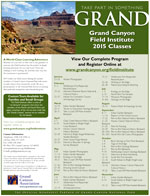About New Histories
.
Tuesday, 13 October 2015
Notes from the Orlop – A Curator-led Discovery
The orlop was a region of a ship under the lower decks well below the waterline, a place of darkness, seepage, clutter and mystery. Periodically, I will reveal here extraordinary, intriguing, and unexpected items from our storerooms that may surprise you with their diversity. My latest exploration is below. Previous Notes can be accessed by choosing from the topics in the left column.
Welcome to the Orlop! Your feedback is welcome. Chris Hall, Curator of Exhibits
Orlop No. 39: A Blast from the Past

Plate 1 in The eruption of Krakatoa, and subsequent phenomena. Report of the Krakatoa Committee of the Royal Society (London, Trubner & Co., 1888)
An eggplant-size specimen of volcanic pumice in our collection connects a Freeport mariner to the cataclysmic eruption of Krakatoa in late August, 1883. By 1881, Captain Rufus S. Randall was winding down a long, successful career as a mariner, that he began in 1841 at age 11 as a ship’s boy following the loss of his father at sea. He ultimately progressed to becoming a ship master by 25, and captained numerous vessels around the world, including the 2110-ton ship JOHN A. BRIGGS, launched at Freeport in 1878 - the largest ship built there -, and the 1106-ton bark OASIS, also built at Freeport in 1871 by Briggs & Cushing.
Randall was also a stake-holder in these two vessels, not uncommon for a shipmaster; he held a 5/64th share in the JOHN A. BRIGGS, and a substantial ¼ share in the OASIS. After ending his blue-water days, he took up farming in Freeport, but remained a ship manager/agent for Briggs & Cushing who were majority shareholders in these vessels. Whenever these ships returned to the US, ships that Randall knew well having commanded them, he would travel to New York or Philadelphia to manage the discharging of their cargo, and enable subsequent refits and drydocking for new ‘metaling’ – the replacement of the anti-fouling copper alloy sheathing below the waterline.
The Randall collection at MMM includes a number of personal journals of the captain’s, which reveal glimpses, in his blessedly legible, succinct entries, of a mariner’s life that is, not surprisingly, as much concerned for family and friends ashore as for the workings of his vessels.

The late summer of 1883 found Randall savoring the husbandry of his semi-retired farming life in Freeport: “August 23 - Commenced digging potatoes. They are first class.” “August 25 – Pull and stack yellow eye beans.” But the pastoral reverie was jarred: “August 29, 1883 – Hear of a terrible earthquake which has destroyed parts of Java about the Straits of Sunda. The OASIS will be due at Anjer in about 30 days. Am glad I got some insurance on her.” [The week before: “August 20 – Go to Portland, insure at Portland Lloyds $3000 my part Bark OASIS.”]

The farmer is pushed aside as the seasoned voyager in Randall noted this extraordinary news flashing around the globe on the telegraph wires; he might well have had growing concern for the vessel which had underwritten his Freeport property, as his ¼ share of the OASIS approached a port that had been wiped off the earth in an epic geological disaster that generated the loudest detonation ever recorded and a tsunami that went around the world. He could only project her location based on dead reckoning from shipping reports.

One such report in the New York Herald “Vessels Spoken” column of Sept. 8, 1883 had the OASIS, Capt. Call, master, for Anjer, reported ‘on the Line’ (at the Equator) at longitude 30˚W, (off the coast of Brazil), on August 10, presumably reaching southward into the south Atlantic to catch the westerly trade winds across the Indian Ocean toward Indonesia. Randall was undoubtedly calculating just how close the OASIS would have come to the Sunda Straits in 17 days, the day of the eruption on Aug 27.
With the benefit of hindsight (and Google Earth), assuming a 10,500 mile track to Java from the OASISequatorial spotting, and assuming (optimistically) 200 mile daily runs for the OASIS (about 8+ knots/hr steady for 24 hours), the ship could have traveled 3400 miles from her spoken location, placing her very roughly off Cape Town on the day the Krakatoa tsunami propagated around the world’s oceans. (It was recorded reaching Port Elizabeth, South Africa about 13 hours after the blast at a crest height of 1 meter.) Because such waves cannot be detected at sea (only when they break ashore), the wave itself was not the danger to the ship, but rather the state of affairs in Java.
Randall’s diary for the rest of the 1883 year bears no mention of the OASIS. Meantime, he spent several weeks away from Freeport, tending to the JOHN A. BRIGGS which turned around in Philadelphia; between the scribbled notations of cash outlays for mending and provisioning the big ship, he lamented being overcome with homesickness for the farm and his family. With relief, he was home to Freeport again by Thanksgiving, the BRIGGS loaded, manned and departed; he was planning a hen house for the new year, and sleighing into Portland with his wife for shopping after the first snow. Then came New Year’s Eve.
“Monday, Dec 31, 1883: Harness up and take a sleigh ride. Brigg’s and Cushing get a letter from Capt. Call, OASIS, from Samarang.” Big news. The ship is heard from at the large port on the north side of Java [now spelled Semarang]; Anjer [now Anyer], only 30 open sea miles from the Krakatoa caldera, had been wiped out; thousands had died. Vast floating mats of pyroclastic ejecta – cinders, ash, pumice – were reported drifting for miles at sea, some supporting tree trunks and even corpses. Captain Call would likely have received word of the disaster from westbound shipping as he worked OASIS up to the Sunda Strait, but he would have had to formulate a Plan B given that his port-of-call was annihilated.
(below) MMM’s January 1884 edition of the 1868 Admiralty chart of the approaches to Sunda Straits has overlay notations related to the eruption. The red arrow points to Anjer “Totally destroyed” and a sentence that sweeps up the coastline “All these villages totally destroyed by the volcanic eruption …”

(below) The same chart attempts to fathom the chaos at the other side of the strait, with a welter of new soundings widely diverging from the old. The colored ellipse indicates the rough outline of the vanished island, much it spewed not only into the nearby ocean but literally around the world in a trans-global dust cloud. Pumice chokes the surrounding waters, as the chart warns (red arrows). Is it floating, or awash against a new concealed volcanic hazard? A mariner’s nightmare.

We have no record of Call’s Java landfall, but to reach Samarang he would have passed through Sunda let’s say Oct 1, maybe five weeks after the eruption. The debris from the volcano lingered in the ocean for months, with reports of floating pumice mats reaching Africa over a year later, worn and rounded. Though the pumice nodule in MMM’s Randall collection has no recorded provenance beyond coming from the family, it seems not unlikely to be associated with the passage of the bark OASIS through Sunda in the aftermath, a unique keepsake brought home to Randall at the Freeport farm by Capt. Call, one shipmaster of the OASIS to another. The New York Herald reported the OASIS outbound from Manila for New York on April 15, 1884; her cargo was probably Java sugar, Philippine hemp and likely included one small piece of pumice plucked from mightily troubled waters.

January 7, 1884: Got $1800 check from Briggs & Cushing, my part of £1500 sent from bark OASIS at Samarang, Java. Clear sledding ahead for the 54 year-old shipmaster; Rufus died in 1888, four years and one fine henhouse later.

History & Culture
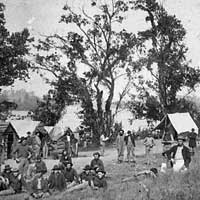
Union Soldiers near Chattanooga, TN
Library of Congress
Through a series of skillful marches, Union General William S. Rosecrans forced Southerners under General Braxton Bragg to withdraw from Middle Tennessee to Chattanooga. Bragg dug in, guarding the Tennessee River crossings northeast of the city. However, early in September, Federals crossed the Tennessee well below Chattanooga, again forcing Bragg to withdraw southward. Eluding his Federal pursuers, Bragg concentrated his forces at LaFayette, Georgia, (26 miles) south of Chattanooga. Here reinforcements swelled his ranks to more than 66,000 men. Twice he unsuccessfully tried to destroy segments of Rosecrans' army. Then, on September 18, 1863, hoping to wedge his troops between the Federals and Chattanooga, Bragg posted his army on the west bank of Chickamauga Creek. Fighting began shortly after dawn on September 19. The armies fought desperately all day, but the Confederates eventually pushed the Federals back to the LaFayette Road. On September 20, Bragg again tried to drive between the Union force and Chattanooga, but failed to dislodge Rosecrans' line. Suddenly, a gap opened in the Federal ranks and Confederates smashed through, routing Rosecrans and half his army. General George H. Thomas took command of the remaining Federals and formed a new battleline on Snodgrass Hill. Here his men held their ground against repeated assaults. After dark, Thomas' forces withdrew from the field to the defenses of Chattanooga. The Confederates pursued and besieged the city. By placing artillery on the heights overlooking the river and blocking the roads and rail lines, the Southerners prevented Federal supplies from entering the city. 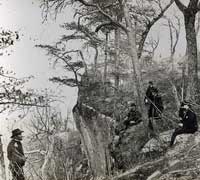
General Grant (left) stands on Lookout Mountain.
Brooklyn Public Library
Within days of Grant's arrival in October, the situation began to change dramatically. Federal troops opened a supply route, nicknamed the "Cracker Line," from Bridgeport, Alabama. On November 23 Thomas' men attacked and routed the Confederates from Orchard Knob. On the 24th, aided by a heavy fog that enshrouded the slopes of Lookout Mountain, Hooker's soldiers pushed the Confederates out of their defenses. On November 25, with most of Bragg's army now concentrated on Missionary Ridge, Grant launched Sherman's troops against the Confederate right flank, and sent Hooker's men from Lookout Mountain to attack the Confederate left. Thomas' soldiers were sent to relieve the pressure on Sherman by assaulting the rifle pits at the base of Missionary Ridge. This was swiftly accomplished, but then, without orders, Thomas' men scaled the heights in one of the great charges of the war. The Confederate line collapsed and Bragg's troops fled to the rear, retreating into Georgia. The siege and battle for Chattanooga were over and Union armies now controlled the city and nearly all of Tennessee. The next spring, Sherman used Chattanooga for his supply base as he started his march to Atlanta and the sea.
Additional Resources:
|
Monday, 28 September 2015
L. Francis Herreshoff: Yacht Designer

Mystic Seaport is proud to announce the release of its latest book, L. Francis Herreshoff: Yacht Designer by Roger C. Taylor. The book is the first of two volumes to chronicle the life and work of the most remarkable yacht designer of his time.
Francis Herreshoff lived from 1890 to 1972, and, though not prolific, he designed yachts that will always be considered classics. Beginning his career in the shadow of his famous father, Nathanael G. Herreshoff, he emerged to become a designer who would come close to the perfection of form in yacht design. Despite his exquisite designs and wise, published writings on the subject, L. Francis never achieved the popularity of a John Alden or an Olin Stephens, yet his influence on yachting, now and in the future, deserves its place alongside those leaders. It is a purpose of this book to allow that possibility by presenting evidence of Francis Herreshoff’s genius for public judgment.
As a young man, Mr. Taylor was acquainted with Mr. Herreshoff. As the founder of International Marine Publishing Company, he published Herreshoff’s Sensible Cruising Designs and An L. Francis Herreshoff Reader. Taylor is a professional mariner with unusually wide experience, including a working familiarity with boats built to many of Herreshoff’s designs. He is the author of seven books on yacht design and seamanship.
Mystic Seaport commissioned Taylor to write Herreshoff’s biography and made available to him the L. Francis Herreshoff Collection at the Museum. Taylor’s research has been painstaking and thorough. He has studied the entire collection of plans and letters, has conducted dozens of in-depth interviews with Herreshoff’s relatives and friends and with owners of Herreshoff boats, and has consulted published yachting books and magazines.
“I feel so privileged to be given the time and space to develop a detailed biography of L. Francis Herrehoff. Getting to know him and his designs in depth has been a most rewarding experience, an experience I am delighted to share,” said Taylor.
In the book, Taylor brings Herreshoff’s personality to life, with its artistic and scientific genius, prejudices, omniscience, shyness, quiet friendliness, inward pain, and generosity. He presents a gallery of plans and photographs of Herreshoff’s yachts, with expert descriptions and commentary on the details of his designs. He shows how Herreshoff went about his work, what his daily life was like. He portrays Herreshoff as collector of fine art and antiques, as a master craftsman who made for his friends myriad distinctive objects in wood and metal. Taylor weaves into the story Herreshoff’s complex relationship with his famous father, based on the surviving correspondence between them, as well as interviews with the handful of Herreshoff’s friends who were close enough to him to be privy to his own account of that relationship. Taylor tells of Herreshoff’s many friendships with young and old of both sexes.
Because of the desirability of presenting plans, photographs, and detailed text on each one of Herreshoff’s complete designs, as well as telling a comprehensive story of his life, Taylor has broken the work into two volumes. Volume 1 takes the story up through the design of the J-boat Whirlwind, a contender for the defense of the America’s Cup in 1930, a definite turning point in Herreshoff’s life and work. Volume 2 will complete the story and will be ready for publication two years after Volume 1.
“We are very pleased to be able to help Roger bring this book to reality, and we believe L. Francis Herreshoff: Yacht Designer will be an important addition to yachting history and will be a fine exposition of one the primary collections of Mystic Seaport,” said Mary Anne Stets, the Director of Intellectual Property and Business Development for the Museum.
12 Oldest Places in America
Just how far back in time does human achievement go in this country? We challenged ourselves to find out and in the process discovered everything from a prehistoric settlement near St. Louis to a pirate bar in New Orleans.

Pirates started slinging grog at Jean Lafitte's Blacksmith Shop in New Orleans back in 1722.
(Courtesy Infrogmation/Wikimedia Commons)
(Courtesy Infrogmation/Wikimedia Commons)
SEE THE PLACES!
SEE WHERE HISTORY COMES TO LIFE
Oldest City: Cahokia, c. 700–1400
UNESCO officially named Cahokia (15 minutes from modern-day St. Louis) the largest and earliest prehistoric settlement north of Mexico back in the 1980s. It was thought to be just a seasonal encampment, important but not that exciting. Then, in January 2012, reports were released showing that this was actually the first true North American city: 500 thatch-roofed rectangular houses were gridded around ceremonial plazas and stretched eight miles on either side of the Mississippi River; at its peak it had 20,000 inhabitants. Visit the Cahokia Mounds State Historic Site and get a sense of the scope from the top of Monks Mound, a 100-foot-tall monumental outlook that took an estimated 22 million cubic feet of earth to make. 30 Ramey St., Collinsville, Ill., 618/346-5160, cahokiamounds.org. Suggested donation $4 per person.Oldest Art: Chumash Cave Painting, c. 1000
Art, much like beauty, is in the eye of the beholder. Still, few can debate the impressiveness of these 500-plus-year-old rock paintings in Chumash Painted Cave State Historic Park in the Santa Ynez Mountains near Santa Barbara, Calif.. Colorful and abstract symbols, possibly representing mythic figures or natural phenomena (like a 1677 solar eclipse), were applied with crushed mineral pigment for unknown reasons. Is it art? Is it graffiti? Bring a flashlight and theorize away. The paintings are easily viewed behind a protective grate after a short, steep hike. Painted Cave Rd., Santa Barbara, Calif., 805/733-3713, parks.ca.gov.Oldest Community: Acoma Pueblo, c. 1150
Seventy miles west of Albuquerque, N.M., the Acoma people have lived continuously for nearly 900 years atop a 367-foot sandstone bluff. Homes are multi-story, multi-family "apartment complexes" that can be reached only by exterior ladders, much like the cliff cities of Mesa Verde and Gila, where their first nation brethren the Anasazi and the Mogollon lived, respectively. Group tours depart daily from Sky City Cultural Center at the bottom of the mesa, while the Haak'u Museum screens culturo-historical videos, offers fantastic pottery for sale (with plenty more vendors outside), and fry bread with green chile stew in the café. Interstate 40 & Exit 102, 800/747-0181, sccc.acomaskycity.org. Guided tours $20 per person.Oldest Timber Frame House: The Fairbanks House, c. 1637–1641
Thanks to the magic of dendrochronology (a.k.a. tree-ring dating), the Fairbanks House was declared North America's oldest timber-framed house. It's amazing that the wooden house is still standing, about 375 years after it was built. Eight generations of the Fairebanks family lived in this homestead, 25 minutes outside of Boston, first in the two-story, two-room core, and later, as fashions dictated and wealth allowed, throughout its "new" additions. No grand renovation ever unified the various sections, so much of the original handiwork and historical details and construction techniques have remained. The house now exists as a museum and contains furniture, paintings, and other artifacts from the Fairbanks family. 511 East St., Dedham, Mass, 781/326-1170, fairbankshouse.org. Open May 1 through October 31. $12 admission.Download the Park Newspaper for the South Rim of Grand Canyon
Rim of Grand Canyon
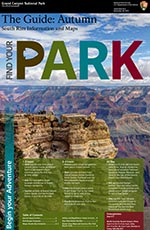 Download the 2015 Autumn (English)
Download the 2015 Autumn (English)
September 8 - November 30, 2015
Autumn South Rim Guide (letter-size)
(Prints on 8.5 x 11" paper 1.7 MB PDF File)
Autumn South Rim Guide (tabloid size)
(Prints on 11 x 17" paper 2.5 MB PDF File)
Contains maps, schedules and information.
South Rim lodging and camping along with most other visitor services within the park are open all year.
Reserve lodging and campsites as far ahead as possible, especially during busy summer and fall months.
Download Autumn South Rim Village Shuttle Bus/ Parking Map
as one large page 22.5 x 17" (1.1 MB PDF file)
 PDF Display or Printing Issues?
PDF Display or Printing Issues?
Using a web browser to view and print our PDF publications? You may experience issues where the PDF does not display or print correctly.
Some web browsers do not automatically open PDFs using the Acrobat Reader application. Things to try (1) Select the Acrobat Reader plug-in for your browser's default application for viewing/ printing PDFs. or (2) You can right click and save the PDF document to your desktop and then open it with the Adobe Reader application, and print from there. Get the newest version of free Adobe Reader.
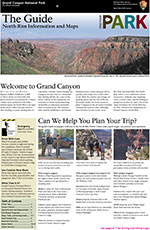 Download the 2015 Season (English)
Download the 2015 Season (English)  Grand Canyon National Park Newspapers
Grand Canyon National Park Newspapers
Follow the Newspaper Feed and be able to download the park's newspapers as soon as they are published. Learn how by visiting the Grand Canyon RSS Information page. 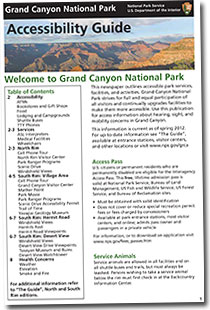 A digital copy of the Grand Canyon National Park Accessibility Guide may be downloaded below:
A digital copy of the Grand Canyon National Park Accessibility Guide may be downloaded below:
Accessibility Guide (2012)
for printing on standard letter-sized paper (1.2 MB PDF file)
Accessibility Guide (2012)
Large Type Version
for printing on 11 x 17" paper
(1.6 MB PDF file)
If you have accessibility questions about Desert View, the North Rim, or elsewhere in the park, you may email us here.
Upon your arrival at the park, a paper copy of the Accessibility Guide is available upon request at the Grand Canyon Visitor Center, Yavapai Museum of Geology, Kolb Studio, Verkamps Visitor Center, Tusayan Museum, Desert View Visitor Center, or North Rim Visitor Center.
Several of the daily Interpretive Ranger Programs are wheelchair accessible. Inquire at visitor centers or look in the "Grand Canyon Guide" newspaper for specifics.
 Grand Canyon National park also publishes a variety of brochures and one-page bulletins.
Grand Canyon National park also publishes a variety of brochures and one-page bulletins.
These publications are distributed in the park and may also be downloaded in PDF format from the Brochures Web Page.
All of these digital publications require the free Adobe Acrobat Reader for viewing. For best results, we suggest that you download the file to your computer before viewing or printing.
Many more publications are available through the park's online bookstore, operated the Grand Canyon Association.
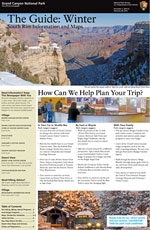 Download the 2014 Winter (English)
Download the 2014 Winter (English)
December 1, 2014 - February 28, 2015
Winter South Rim Guide (letter-size)
(Prints on 8.5 x 11" paper 4.1 MB PDF File)
Winter South Rim Guide (tabloid size)
(Prints on 11 x 17" paper 2.9 MB PDF File)
Contains maps, schedules and information.
South Rim lodging and camping along with most other visitor services within the park are open all year.
Reserve lodging and campsites as far ahead as possible, especially during busy summer and fall months.
Download Winter South Rim Village Shuttle Bus/ Parking Map
as one large page 22.5 x 17" (1.9 MB PDF file)
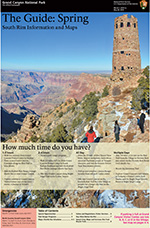 Download the 2015 Spring (English)
Download the 2015 Spring (English)
March 1, through May 20, 2015
Spring South Rim Guide (letter-size)
(Prints on 8.5 x 11" paper 2.5 MB PDF File)
Spring South Rim Guide (tabloid size)
(Prints on 11 x 17" paper 2.4 MB PDF File)
Contains the maps, schedules and information needed to plan a South Rim visit.
South Rim lodging and camping and most other visitor services are open all year.
Reserve lodging and campsites as far ahead as possible, especially if you plan to visit during the busy summer and fall months.
Download Spring South Rim Village Shuttle Bus/ Parking Map
as one large page 22.5 x 17" (1.5 MB PDF file)
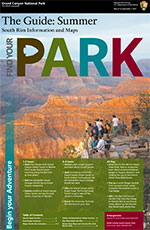 Download the 2015 Summer (English)
Download the 2015 Summer (English)
May 21 - September 7, 2015
Summer South Rim Guide (letter-size)
(Prints on 8.5 x 11" paper 4.5 MB PDF File)
Summer South Rim Guide (tabloid size)
(Prints on 11 x 17" paper 2.3 MB PDF File)
Contains the maps, schedules and information needed to plan a South Rim visit.
South Rim lodging and camping along with most other visitor services within the park are open all year.
Reserve lodging and campsites as far ahead as possible, especially during busy summer and fall months.
Download Summer South Rim Village Shuttle Bus/ Parking Map
as one large page 22.5 x 17" (1.1 MB PDF file)

Park Newspaper
September 8 - November 30, 2015
Autumn South Rim Guide (letter-size)
(Prints on 8.5 x 11" paper 1.7 MB PDF File)
Autumn South Rim Guide (tabloid size)
(Prints on 11 x 17" paper 2.5 MB PDF File)
Contains maps, schedules and information.
South Rim lodging and camping along with most other visitor services within the park are open all year.
Reserve lodging and campsites as far ahead as possible, especially during busy summer and fall months.
Download Autumn South Rim Village Shuttle Bus/ Parking Map
as one large page 22.5 x 17" (1.1 MB PDF file)

Using a web browser to view and print our PDF publications? You may experience issues where the PDF does not display or print correctly.
Some web browsers do not automatically open PDFs using the Acrobat Reader application. Things to try (1) Select the Acrobat Reader plug-in for your browser's default application for viewing/ printing PDFs. or (2) You can right click and save the PDF document to your desktop and then open it with the Adobe Reader application, and print from there. Get the newest version of free Adobe Reader.
Download the Park Newspaper
for the North Rim of Grand Canyon
for the North Rim of Grand Canyon

Park Newspaper
May 15 through October 15, 2015.
North Rim Guide (letter-size)
Pages split to print on 8.5 x 11" paper.
(4.3 MB PDF File)
North Rim Guide (tabloid size)
Prints on 11 x 17" paper
(2.2 MB PDF File)
The 2015 edition of the North Rim Guide contains the maps, schedules and information needed to plan your visit.
The North Rim has a short season, so it is best to reserve lodging and campsites as far ahead as possible.
Download Maps and Trail Guide as one large page 22.5 x 17" (467 kb PDF)
North Rim Guide (letter-size)
Pages split to print on 8.5 x 11" paper.
(4.3 MB PDF File)
North Rim Guide (tabloid size)
Prints on 11 x 17" paper
(2.2 MB PDF File)
The 2015 edition of the North Rim Guide contains the maps, schedules and information needed to plan your visit.
The North Rim has a short season, so it is best to reserve lodging and campsites as far ahead as possible.
Download Maps and Trail Guide as one large page 22.5 x 17" (467 kb PDF)

Follow the Newspaper Feed and be able to download the park's newspapers as soon as they are published. Learn how by visiting the Grand Canyon RSS Information page.
The Grand Canyon Guide is published by Grand Canyon National Park for the orientation and education of visitors to Grand Canyon National Park. This valuable resource is now available for you to download and read/print at your leisure. Layout and design by Ian Ferris.
Grand Canyon Field Institute
2015 Schedule of Classes
(1.0 MB PDF File)
Topics: geology, ecology, history, archaeology, photography, & more.
The Institute offers guided educational tours at Grand Canyon National Park led by expert instructors while hiking, backpacking, camping, & whitewater rafting.
Click here to visit their website.
Learning & Lodging
The Grand Canyon Field Institute (GCA) and Xanterra South Rim, LLC offer fun and informative Learning & Lodging Programs that combine lodging, meals, and two days in the field with an instructor.
2015 Schedule of Classes
(1.0 MB PDF File)
Topics: geology, ecology, history, archaeology, photography, & more.
The Institute offers guided educational tours at Grand Canyon National Park led by expert instructors while hiking, backpacking, camping, & whitewater rafting.
Click here to visit their website.
Learning & Lodging
The Grand Canyon Field Institute (GCA) and Xanterra South Rim, LLC offer fun and informative Learning & Lodging Programs that combine lodging, meals, and two days in the field with an instructor.

park newspaper
Accessibility Guide (2012)
for printing on standard letter-sized paper (1.2 MB PDF file)
Accessibility Guide (2012)
Large Type Version
for printing on 11 x 17" paper
(1.6 MB PDF file)
If you have accessibility questions about Desert View, the North Rim, or elsewhere in the park, you may email us here.
Upon your arrival at the park, a paper copy of the Accessibility Guide is available upon request at the Grand Canyon Visitor Center, Yavapai Museum of Geology, Kolb Studio, Verkamps Visitor Center, Tusayan Museum, Desert View Visitor Center, or North Rim Visitor Center.
Several of the daily Interpretive Ranger Programs are wheelchair accessible. Inquire at visitor centers or look in the "Grand Canyon Guide" newspaper for specifics.

These publications are distributed in the park and may also be downloaded in PDF format from the Brochures Web Page.
- To view a list of park brochures & site bulletins click here.
All of these digital publications require the free Adobe Acrobat Reader for viewing. For best results, we suggest that you download the file to your computer before viewing or printing.
Many more publications are available through the park's online bookstore, operated the Grand Canyon Association.
Back Issues for Reference

Park Newspaper
December 1, 2014 - February 28, 2015
Winter South Rim Guide (letter-size)
(Prints on 8.5 x 11" paper 4.1 MB PDF File)
Winter South Rim Guide (tabloid size)
(Prints on 11 x 17" paper 2.9 MB PDF File)
Contains maps, schedules and information.
South Rim lodging and camping along with most other visitor services within the park are open all year.
Reserve lodging and campsites as far ahead as possible, especially during busy summer and fall months.
Download Winter South Rim Village Shuttle Bus/ Parking Map
as one large page 22.5 x 17" (1.9 MB PDF file)

Park Newspaper
March 1, through May 20, 2015
Spring South Rim Guide (letter-size)
(Prints on 8.5 x 11" paper 2.5 MB PDF File)
Spring South Rim Guide (tabloid size)
(Prints on 11 x 17" paper 2.4 MB PDF File)
Contains the maps, schedules and information needed to plan a South Rim visit.
South Rim lodging and camping and most other visitor services are open all year.
Reserve lodging and campsites as far ahead as possible, especially if you plan to visit during the busy summer and fall months.
Download Spring South Rim Village Shuttle Bus/ Parking Map
as one large page 22.5 x 17" (1.5 MB PDF file)

Park Newspaper
May 21 - September 7, 2015
Summer South Rim Guide (letter-size)
(Prints on 8.5 x 11" paper 4.5 MB PDF File)
Summer South Rim Guide (tabloid size)
(Prints on 11 x 17" paper 2.3 MB PDF File)
Contains the maps, schedules and information needed to plan a South Rim visit.
South Rim lodging and camping along with most other visitor services within the park are open all year.
Reserve lodging and campsites as far ahead as possible, especially during busy summer and fall months.
Download Summer South Rim Village Shuttle Bus/ Parking Map
as one large page 22.5 x 17" (1.1 MB PDF file)
Saturday, 25 July 2015
Building the Gold Mountain

As part of the commemoration of the 125th anniversary of Philadelphia's Chinatown in 1995, a plaque was affixed to the wall of the H.K. Golden Phoenix Restaurant at 913 Race Street, where the city's first Chinese laundry was established in 1870. It reads: "In commemoration of our forefathers, this plaque is dedicated to those who came to the gim san (gold mountain) to seek their fortunes."
While this plaque communicates the hopes of the early Chinese immigrants, it doesn't communicate how they came to Philadelphia and built a community through years of unremitting effort and struggles against discrimination.
The photographs and objects in this exhibition illustrate how these immigrants, under changing social and political conditions, tried to maintain their cultural identity while becoming a part of American society.
J.G. Brill Company Photographs

Topics
Industry,
Philadelphia
The J.G. Brill Company and its various incarnations dominated the world of trolley and undercarriage manufacturing for most of its seventy-year history. Based in Philadelphia, Brill was founded in 1868 by a German immigrant and held in family hands well into the 1930s. At its height, The J.G. Brill Company owned plants in six states as well as in Canada and France.
Records of the J.G. Brill Company include approximately 16,000 photographs, 6000 glass-plate negatives, 10,000 acetate negatives, and thirteen order books documenting the wide array of products manufactured by Brill. The photographs include interior and exterior views of railroad cars, trolleys, buses, ambulances, and trucks, as well as images of undercarriages, small parts, and seats. The collection also documents the factory grounds at 62nd and Woodland, particularly for World War I. Order books provide information on the quantity and types of items purchased, the companies purchasing them, and their dates of order and delivery.
Subscribe to:
Comments
(
Atom
)

